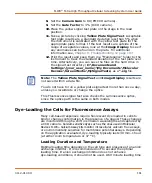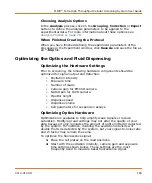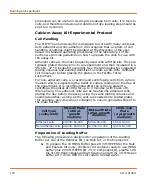
Running an Experiment
158
0112-0109 H
Cell Densities
Cell densities used in fluorescence assays vary because each cell type
has different requirements. Cell densities range from 1,500 to 5,000
cells per well for 1536-well plates, 5,000 to 20,000 for 384-well plates
and 20,000 to 80,000 cells per well for 96-well plates. Non-adherent
assays require higher cell densities.
It is necessary to optimize the cell seeding density so that a uniform,
80–90% confluent monolayer is formed on the day of the experiment.
Over- or under-confluent cell monolayer may result in reduced cellular
response to the test compounds.
Cells that are normally maintained in culture at subconfluent levels
should be seeded at relatively low densities. Depending on the
individual cell line, attachment matrix-coated plates (such as the poly
D-lysine coated plate) might be required to improve adherence and
minimize cellular “blow-off” during compound addition. Assay
development needs to be performed to determine the optimal seeding
density and plate environment for each cell line.
Cell Seeding
Cells can be seeded in plates using a multi-channel pipettor or a liquid-
dispensing system, such as the AquaMax
®
DW4 Dispenser from
Molecular Devices. We recommend seeding a 1536-or 384-well cell
plate using an automatic instrument rather than seeding manually. Thin
needles used in automatic liquid-dispensing instruments prevent air
bubble formation in well bottoms—a problem commonly encountered
when cells are seeded with a manual pipettor. 96-well plates can be
seeded by either manual or automatic methods. Please refer to your
specific instrument’s user guide for instructions on how to dispense cell
suspension into wells.
Cells are seeded in clear, flat-bottom, black-wall 1536-, 384- or 96-well
tissue culture treated plates. A flat plate bottom ensures that cellular
fluorescence is localized to a single horizontal plane. Adherent cells
typically are seeded one day before an experiment. Non-adherent cells
are either plated one day before on a coated plate or the day of an
experiment. All steps are carried out in the same black-wall 96-, 384-
or 1536-well plate.
Note:
Flat-bottom, clear-wall tissue culture plates may also be used
with the FLIPR
®
Calcium assay Kit and Membrane Potential Assay Kit.
Depending on signal intensity, either black-wall or white-wall plates
can be used when running aequorin assays.
Содержание FLIPR Tetra
Страница 1: ...FLIPR Tetra High Throughput Cellular Screening System User Guide 0112 0109 H December 2011...
Страница 12: ...Contents 12 0112 0109 H...
Страница 16: ...System Overview 16 0112 0109 H...
Страница 40: ...System Hardware Features 40 0112 0109 H...
Страница 148: ...Exchanging Hardware 148 0112 0109 H...
Страница 156: ...Calibration and Signal Test 156 0112 0109 H...
Страница 196: ...Running an Experiment 196 0112 0109 H...
Страница 232: ...Robotic Integration 232 0112 0109 H The following drawings illustrate these requirements...
Страница 282: ...Data Processing Algorithms 282 0112 0109 H...
Страница 294: ...Consumables and Accessories 294 0112 0109 H...
Страница 298: ...Using AquaMax Sterilant 298 0112 0109 H...
Страница 302: ...Electromagnetic Compatibility EMC 302 0112 0109 H...






























